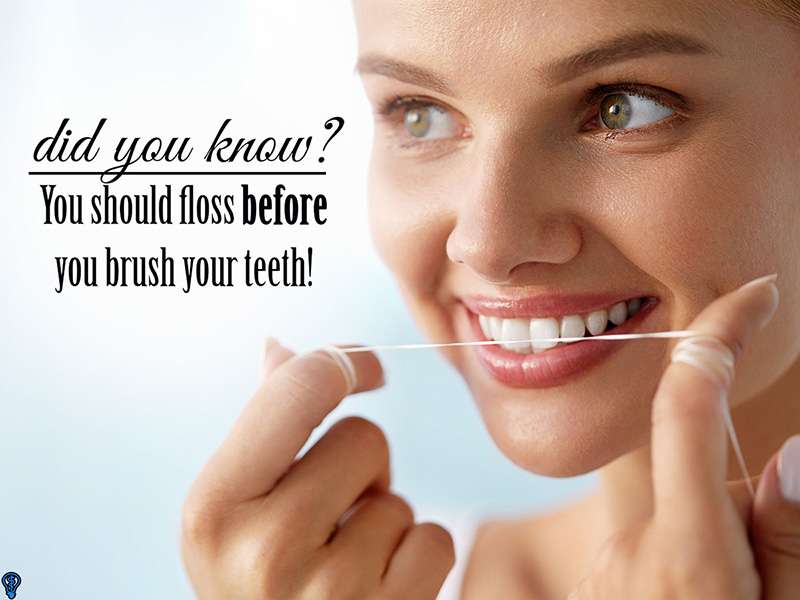Oral Hygiene Basics Miami, FL
At Dr. Rita The Smile Designer, we help patients throughout Miami to stay in excellent oral health. With a focus on preventative care, we take the time to get to know each of our patients, creating a plan for lifelong oral health. With only one set of permanent adult teeth, it is important to care for them and be proactive in taking the steps to prevent cavities, infections, and gum disease. We recommend that you visit our dental office for a teeth cleaning twice a year so that we can remove plaque buildup and tartar, keeping your mouth healthy and clean. To schedule an appointment, call (305) 858-0505. In the meantime, here are steps that you can take at home to keep your mouth healthy.
Oral Hygiene Basics
Keep your smile healthy by brushing properly. Brushing properly and regularly means flashing your best, most healthy smile.
How to brush correctly:
Dr. Rita recommends brushing two to three times a day to promote dental health. Make the most of that time by updating your brushing technique.
The following steps will help you get the most thorough clean:
How to floss correctly:
Flossing is key to maintaining a healthy smile. As we know, gum disease starts at or below the gum line, at times extending between teeth. Regular flossing helps remove the plaque from these areas where a toothbrush cannot reach completion. Remember, floss only the teeth you want to keep!
The American Dental Hygienist’s Association presents proper flossing techniques in four key elements:
Choose the right toothpaste
Toothpaste containing fluoride helps strengthen weak spots and prevent tooth decay. Ask Dr. Rita and her team to recommend one which addresses your specific needs.
Sensitive teeth can benefit from specific toothpastes and rinses designed to alleviate the discomfort associated with thermal or air sensitivity.
Medical toothpastes and rinses are available by prescription for more challenging to treat cases. Ask Dr. Rita what she thinks may help you the most. Keeping your mouth clean and free of plaque is the first step in alleviating tooth sensitivity.
The general recommendation is to use as little toothpaste as possible, minimizing the use of abrasive, whitening toothpastes. These have been shown to irritate the enamel and gums, resulting in tooth abrasion, heightened sensitivity, and a greater incidence of gingival (gum) recession.
Change your toothbrush
Dr. Rita recommends replacing your toothbrush every three months. The right toothbrush for you depends on your specific needs, dental condition, and manual dexterity (or ability to use your hands and fingers properly). Many different types of toothbrushes are available. These range from manual to sonic/rotary/electric pieces. Also available are home care accessories that are used to address open spaces at the gum line, implant restorations, specific periodontal issues, and even orthodontic scenarios. Your specific needs may be identified, and a special brush and, or, accessory recommended just for you. Our well-trained team is available to assess, educate, and present you with what we feel would work best for your smile and oral health.
How to brush your teeth properly
As a Miami dentist, we know that how you brush your teeth is just as important as how often you brush them. It is important that you use a soft toothbrush that will not irritate your gums or cause the enamel on your teeth to erode. Many people make the mistake of thinking that a hard toothbrush is necessary for keeping teeth clean, but this is not the case. As long as you brush correctly a soft toothbrush will work equally well without damaging your teeth. Be sure to brush your teeth in a circular pattern, starting at the gum line and working your way towards the center of your mouth. This will move food particles, bacteria, and plaque away from your gum line. Brush your teeth in quadrants and be sure to brush each section for at least thirty seconds. While brushing you should apply even pressure but not be too aggressive. You should also use fluoride toothpaste since this will provide additional protection from cavities. We recommend that you brush three times a day – morning, after lunch, and before bed. This will keep your mouth clean without causing irritation from over-brushing. Additionally, be sure to buy a new toothbrush every three months or sooner if your bristles are frayed or your toothbrush is stained or smelling.
Flossing is essential for your teeth and gums
At Dr. Rita The Smile Designer, we remind our patients that it is critical to floss on a daily basis. If you live in the Miami area and have not been to the dentist lately, we invite you to schedule an appointment so that we can clean your teeth and remove the plaque and bacteria from hard to reach places. Afterward, it is up to you to floss on a daily basis to remove food particles and plaque from in between your teeth. If they remain in place, you can develop gum disease which is both uncomfortable and dangerous to your oral and overall health. Gum disease occurs when plaque forms underneath the gum line and not flossing can lead to this. If you do not particularly enjoy flossing, buy a plastic flossing tool that you can hold and throw away once done. This makes it easier to get the job done.
Selecting the right mouthwash
When you use mouthwash, it is important to be sure that it is sugar-free. We also recommend using mouthwash that contains fluoride since this will help to kill any lingering bacteria while strengthening your teeth. Carry a bottle of mouthwash with you and rinse your mouth with it after meals, drinking a soda, or consuming coffee. As a Miami, FL dentist office, we understand that it is difficult to brush more than a couple of times per day. Rinsing your mouth, however, is relatively easy, and everyone has time for it. Taking this simple step can help to reduce your risk of cavities and gum disease.
Check out what others are saying about our oral hygiene support services on Yelp: Oral Hygiene Basics Miami
How to prevent tooth decay
Our team prevents tooth decay every day by helping our patients to have clean and healthy teeth. Tooth decay starts when plaque is left on the teeth, and the acid inside of it starts to eat away at the enamel. Keeping teeth clean by removing plaque, therefore, prevents tooth decay. Simultaneously, at home you can continue to brush your teeth and floss after meals. If you do not have anything with you, rinse your mouth with water. This will help to remove some of the loose food particles that may be in your mouth or to remove some of the sugar from your teeth. You should also eat a healthy diet since everything that you eat is directly placed onto your teeth.
What you should know about getting a fluoride treatment
At Dr. Rita The Smile Designer, we are a family dentist office that uses fluoride on a regular basis. We recommend that all of our youth patients under the age of eighteen have a fluoride treatment, at least once a year. Statistically, these treatments reduce the risk of getting cavities by 30 percent. This is significant considering that tooth decay is one of the primary reasons children miss days from school. Adults can also benefit from receiving a fluoride treatment and if you would like to find out if it is right for you, call 3058580505 to schedule an appointment. The treatment itself only takes a couple of minutes. The fluoride is applied directly to the teeth. It has no odor or smell and after a few minutes, patients are free to leave. It is one of the easiest ways to prevent cavities.
How to select the right toothbrush
Patients of our general dentist office are given a toothbrush at each visit. We recommend that you use it for three months and then replace it. When purchasing a toothbrush, look for a soft one that will not irritate your gums or erode your enamel. Otherwise, we suggest a battery operated or electric toothbrush since they can give you the best clean. The toothbrush head rotates while you are moving the brush around, helping you to break up more plaque for the cleanest possible teeth.
Food and drinks that you should avoid
As a family dentist office, we recommend that you avoid drinking too much soda, juice, coffee or anything that contains a lot of sugar. You should also stay away from candy, desserts, and particularly sour candy. Additionally, acidic fruit is bad for your teeth. Any time that you have a diet that is high in sugar and starch it is bad for your teeth because the bacteria on your teeth will thrive in this environment. Simultaneously, when you eat foods that are highly acidic, it can lead to enamel erosion. At Dr. Rita The Smile Designer, we recommend that you eat a diet high in green leafy vegetables, lean protein, dairy, and nuts since they can help to remineralize and strengthen your teeth. For more tips on how to eat a mouth-healthy diet, call (305) 858-0505 and schedule an appointment to speak with Dr. Rita Dargham.
Questions Answered on This Page
Q. Is flossing really important for my teeth?
Q. How can I prevent tooth decay?
Q. What is the best toothbrush for my teeth?
People Also Ask
Q. What are some methods for improving my oral health?
Definition of Dental Terminology
- Cosmetic Dentistry
- Cosmetic dentistry combines comprehensive dental principles with artistic sensibility to design and create optimally healthy and beautiful restorations intended to enhance the appearance of one’s smile while preserving ideal function and form.
- Decay
- Tooth decay is when the enamel of the tooth begins to breakdown as a result of bacterial invasion, causing an acidic induced erosion of healthy tooth structure.
- Dental Caries
- Dental caries are also known as cavities and can result from a lack of proper oral hygiene. A synonym of “decay”, and also called “cavities”, caries is a breakdown of teeth due to acids made by bacteria. The cavities may be a number of different colors from yellow to black.
- Dental Checkup
- A comprehensive oral examination that focuses on the evaluation of hard and soft oral structures including, but not limited to, the teeth, gums, jaw bone, jaw joint, bite, and cosmetic aspects of the smile. Both clinical and radiographic information is used to assess the status of the oral health while detecting any form of pathology that may affect the health of the oral cavity and its associated structures.
- Dental Filling
- A dental filling involves restoring the damaged structure of a tooth by using tooth colored resins or porcelain materials to restore natural form, function, and estethetics to the dentition.
- Dental Prophylaxis
- A dental prophylaxis is a professional and detailed cleaning that involves the removal of plaque, calculus and stains from the teeth,thereby reducing the risks of inflammation and breakdown of the dentition’s supporting structures.
- Dental Sealants
- Dental sealants are preventative restorations that contain a resinous material that is applied to the deep pits and fissures detected on the chewing surfaces of newly erupted teeth. These are used to help prevent dental caries from developing in children’s permanent molars and premolars.
- Dentist
- A dentist, also known as a dental surgeon, is a doctor who specializes in the diagnosis, prevention, and treatment of diseases and conditions of the oral cavity.
- Gingivitis
- Gingivitis is the inflammation of gum tissue that results from plaque, other infections in the mouth, and poor oral hygiene. Gingivitis can be a precursor to more advanced forms of periodontal disease if it is not controlled and reversed. Signs of gingivitis include soft tissue redness,inflammation, and bleeding. Proper brushing, flossing, and prevention helps to prevent and reverse signs of early gum disease.
- Preventive Dentistry
- Preventive dentistry focuses on education, modalities, and treatment designed to achieve and maintain optimal oral health, described as one free of structural, bacterial, and restorative breakdown.
- Tartar
- Tartar forms when plaque builds up on the surface of the teeth and calcifies into a hard surface that is much more difficult to remove. Its presence will require professional dental debridement and education on its prevention. Daily removal of plaque by proper brushing and flossing habits will reduce the incidence of tartar and the pathology associated with its presence.
- Tooth Enamel
- Tooth enamel is the outermost protective layer of the tooth. Enamel is white and visible. Its hard composition protects the underlying layers, dentin and pulp, respectively.
Back to top of Oral Hygiene Basics




